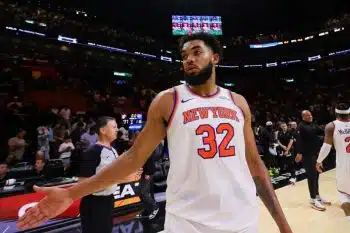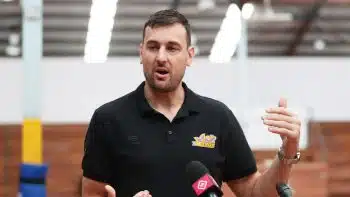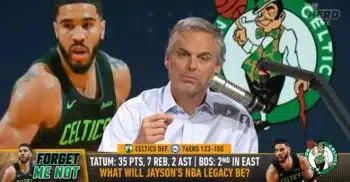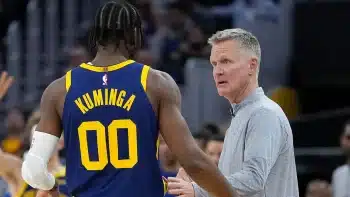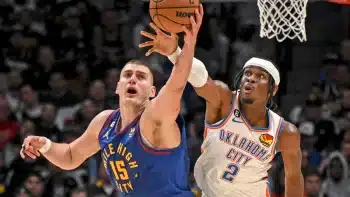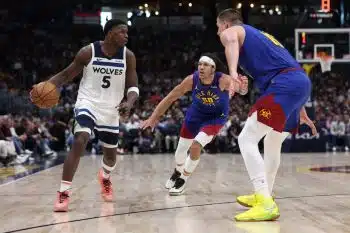NBA
NBA Daily: Is Size Making A Comeback?
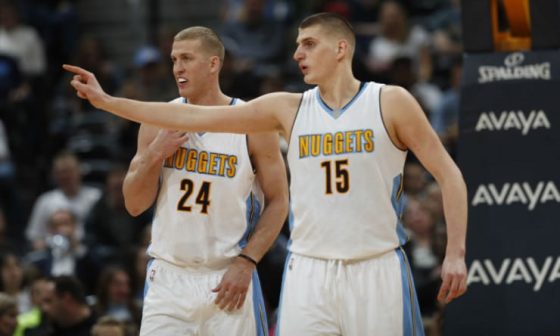
“Twin Towers” used to be a term of endearment in the NBA.
Back in the old days, if you had two dominant seven-footers in your frontcourt, that was considered to be an advantage on the court. Duos like Hakeem Olajuwon/Ralph Sampson and Tim Duncan/David Robinson put their teams on the map. It seems like forever ago now, but once upon a time, the more height you had in your frontcourt, the better.
Then came the invention of small-ball. a scheme that was originally named “Nellie ball” after Don Nelson, who pioneered the strategy in the 1980s when he coached the Milwaukee Bucks. This would be his calling card as a coach, as he used it for the “Run TMC” Warriors, the early Dirk days in Dallas with Steve Nash and Michael Finley and the one-hit-wonder “We Believe” Warriors.
For years, this was a strategy exclusive only to Nelson as the intention to be fatally flawed due to its lack of size would take away from his team’s defenses. As good as his efforts were, they never reached the NBA Finals.
But going smaller grew more prominent as time went on. Mike D’Antoni turned Nellie Ball into the “Seven Seconds or Less” offense that made Phoenix a perennial contender year-in and year-out. Championship teams like the Celtics in 2008 and the HEAT in 2012 found that their best lineups featured their power forwards – Kevin Garnett and Chris Bosh respectively – at the center and their backup wings – James Posey and Shane Battier – as their power forwards.
At the same time, bigs known for their lack of mobility and/or their lack of shooting like Kendrick Perkins and David Lee were getting phased out. Teams who tried to use size to their advantage wound up regretting it. The 2014 Detroit Pistons tried a frontcourt of Josh Smith, Greg Monroe and Andre Drummond – three bigs who could not space the floor – which blew up in their face.
To top it all off, Draymond Green’s coming out party changed the game. For years, fans had been wondering who would have been the perfect center for a small-ball lineup. Green was the answer. His defensive versatility, along with his passing and floor spacing (in the earlier days), allowed the Warriors to play their death lineup with Green manning the five. It unquestionably played an instrumental role in those three championships and in reaching five consecutive finals appearances.
Because of this newly-vaunted lineup, the Warriors had no trouble runnings bigs off the floor — which made it seem like the days of playing two seven-footers at the same time were a thing of the past. It didn’t help that after acquiring DeMarcus Cousins, New Orleans did a merely passable job pairing him up with Anthony Davis, later taking off by replacing the injured Cousins with the smaller Nikola Mirotic.
Was the era of the small-ball lineup a permanent fixture moving forward? It would seem that if you wanted success, or more specifically, wanted to stop the Warriors, you had to play their game. But since last season, or as the final iteration of this version of Golden State, we’ve seen teams bring back lineups that feature two pure or close-to-seven-footers.
Let’s start with the one that’s proven to be a successful pairing: Nikola Jokic and Mason Plumlee. That isn’t the Nuggets’ most-featured duo. Denver usually starts Paul Millsap next to the Joker, and this season, we may not see Plumlee and Jokic share the court as much now that they have Jerami Grant.
Still, these two proved to be an effective pairing last season. Even though both are usually seen as pure centers, in the 549 minutes they shared on the court together, the Nuggets were plus-7.7 together. The success could point to Jokic just being an all-around terror when he’s on the court, but also that Plumlee can hold his own too.
More importantly, it may prove growth among NBA bigs. Jokic didn’t often show it off last year, but his three-pointer is something that teams see as a threat. The added spacing makes it easier to play those two together. It also helps that Plumlee’s mobility makes him one of the better all-around back-up centers, as he’s also an excellent rebounder and passer for his size
The irony here is that Plumlee was acquired for Jusuf Nurkic, who the Nuggets also tried to play next to Jokic. Even though Nurkic is a better talent than Plumlee, putting Nurkic and Jokic together was an all-out disaster.
Jokic and Plumlee isn’t a go-to pairing for Denver, but it is an effective one. Their success together could pave the way for teams to try it out. To be fair, some already have tried to put their bigs together that have led to mixed results. One such pairing is Indiana’s duo of Myles Turner and Domantas Sabonis.
Turner and Sabonis bring unique skillsets to the Pacers. Turner is a rare hybrid of a three-point shooting shot-blocker while Sabonis is more of a post-presence offensively. Indiana has played them together which, at first, wasn’t exactly working in their favor.
Their first season, the two of them were minus-8.7 together on the court, as it seemed as if one took away from the other on both sides of the floor. Last season, there was progress and they were plus-2.8 on the floor together — but the fit still wasn’t exactly great. At times in 2018-19, there were debates on whether they should trade one or the other.
Now, with Thaddeus Young gone, Indiana has decided to put their full trust in these two as their starters. Odds are, the Pacers probably won’t play their finishing lineup with both of them. But they’ll still give this pair more time to work out their kinks together. Basketball Insiders’ Jack Winter already dove into how these two could work, so take a look at his article to educate yourselves further.
Indiana finds themselves utilizing these two because, even if the fit isn’t perfect, they are the two most talented players in their frontcourt. Teams like the Trail Blazers are in a similar position — however, the one difference between them and Indiana is that they are drastically changing up their formula.
For the last few years, Portland has relied on Mo Harkless and Al Farouq-Aminu to play the small and power forward positions. With Harkless in Los Angeles and Aminu in Orlando, Portland had a hole to fill. Instead of trying to find replacements to do what those two did, they decided to switch things up. New acquisition Kent Bazemore, who hasn’t played much power forward in his career, is slated to start at small forward, and third-year seven-footer Zach Collins is should begin at power forward next to Hassan Whiteside.
Playing Collins with their other centers is something they’ve tried before. When he shared the floor with Meyers Leonard last season, they were plus-0.7 together. With Enes Kanter, they were a plus-9.8. With Jusuf Nurkic, they were plus-3.4. Of note, the only pairing of the three listed that saw substantial minutes was him and Leonard.
Now, all three are gone or recovering, and in comes Hassan Whiteside, who is a little different from the others, to say the least. At the top of his game, Whiteside is an elite rim protector/alley-oop finisher, but we haven’t seen that from the center since 2017. Pairing him up with Collins, who is quite mobile for his size and has even shown a so-so three-ball, will definitely factor into how Portland follows up from their most successful playoff campaign since 2000.
The oversized frontcourt pairings that have been mentioned all have one thing in common: They’ll be used on the floor, but they likely won’t be counted on in crunch time. Could there be a team that may count on a two-center pairing when the going gets tough? There just might be with the Chicago Bulls.
There’s a lot of excitement surrounding the next generation of Baby Bulls. Drew Mays already covered all the hype surrounding the Windy City, so let’s cut to the chase: A looming part of their promising future hinges on their frontcourt of Lauri Markkanen and Wendell Carter Jr.
Markkanen is already one of the most promising bigs in the league — highlighted by a phenomenal February where he averaged 26 points on 48/35/92 splits at 21 years old — so his career trajectory should only get higher from here. Carter is a different story as his rookie season was marred by injuries.
Most tragic of all was that by the time the team had acquired Otto Porter Jr., which changed their fortunes for the better, Carter was already out for the season because of a thumb injury. Now he’s coming back to a team that believes they have a clearer identity.
But his fit with Markkanen has been a prickly one. In the 436 minutes they were together on the court, the Bulls were minus-13.7. The upshot is that those minutes were played over a small 21-game sample, most of them came back when the Bulls were the NBA’s doormat too — so why does that feel so long ago when it hasn’t even been a year?
With Chicago on the upswing, they are banking on that these two fitting in together will help the team get back to the playoffs. Markkanen’s already established himself as a deep threat, while Carter came into the league with many believing he could be as well. If they both can space the floor, this could work out as well as they hope, and might just be what encourages teams to put more size in their respective frontcourts again.
Now it’s very possible that we may never see a team finish a game with two centers in the league again. That part of the game may be gone for good — but having more height on your team may not be as much of a disadvantage as we may have thought.
If this trend continues in an upward direction, then maybe size was never really dead to begin with. Perhaps, in the end, frontcourt players just needed the time to evolve — now they’re doing just exactly that.
